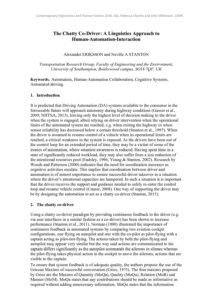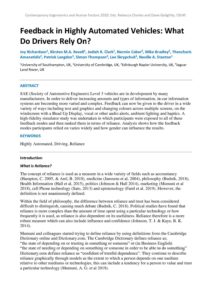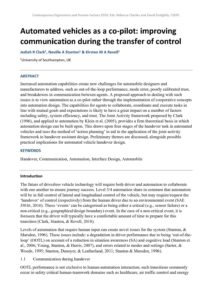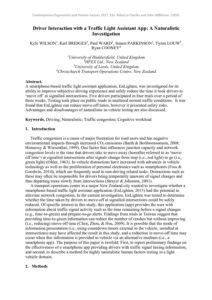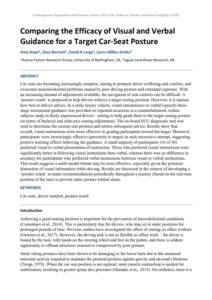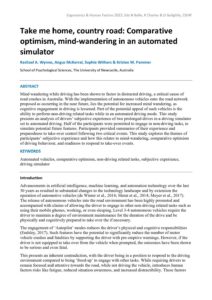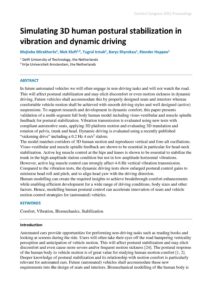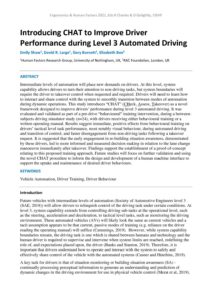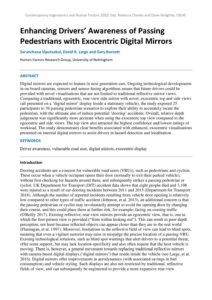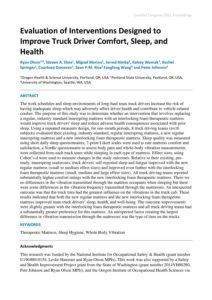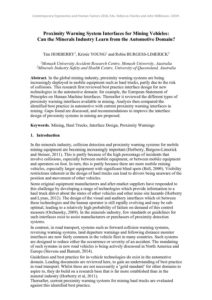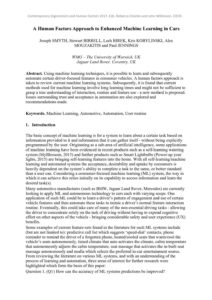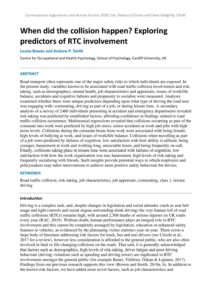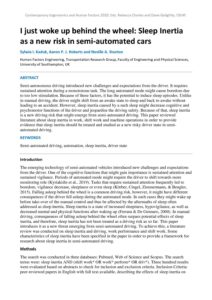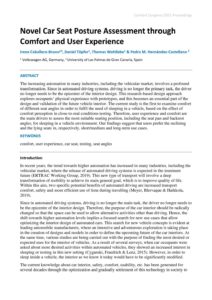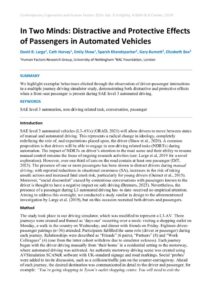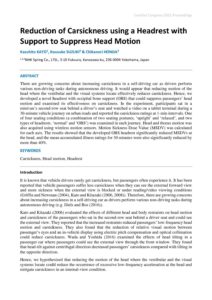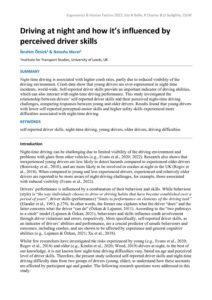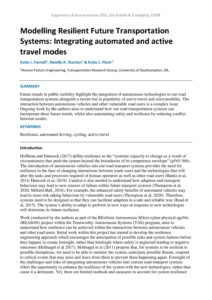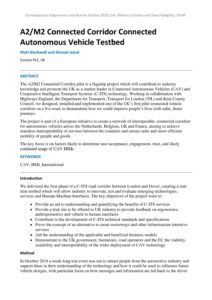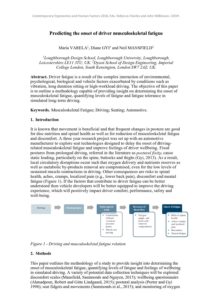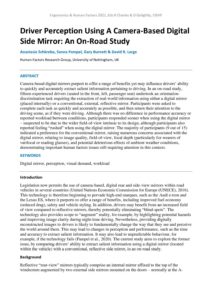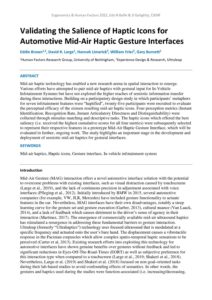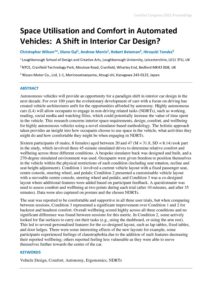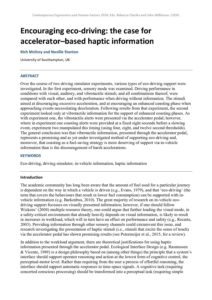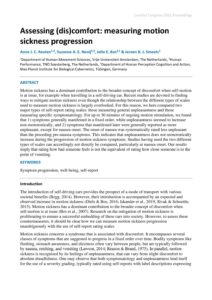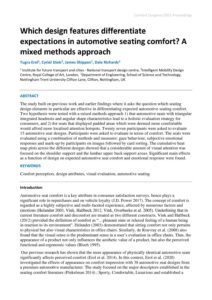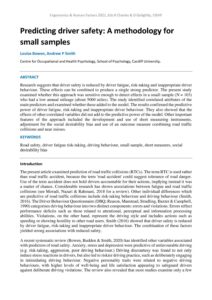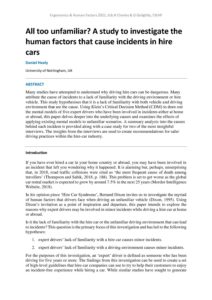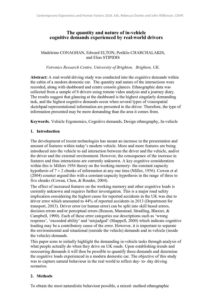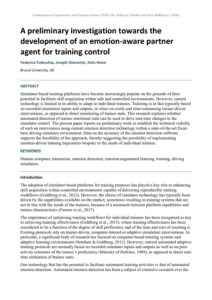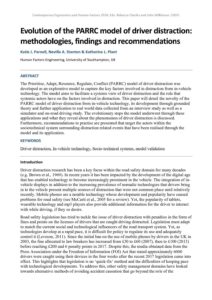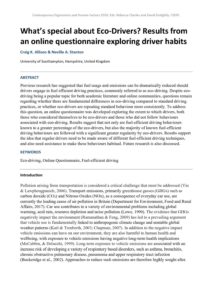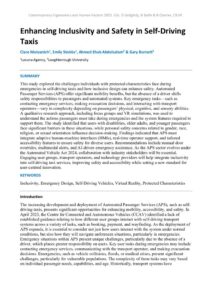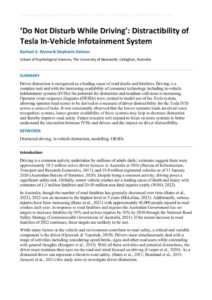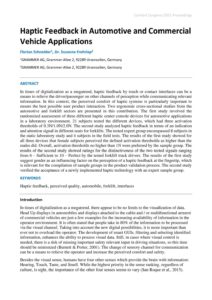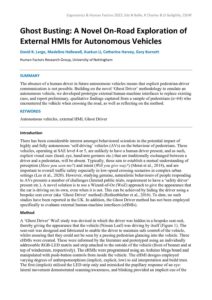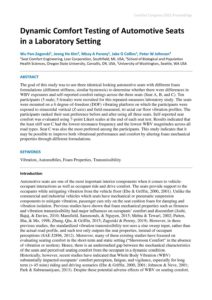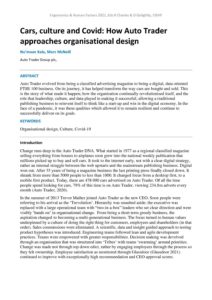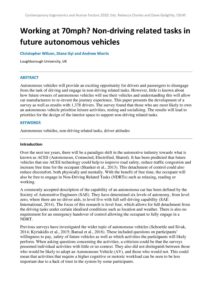Automotive
The Chatty Co-Driver: A Linguistics Approach to Human-Automation-Interaction
| Document | Author Alexander ERIKSSON and Neville A STANTON |
| Abstract |
Feedback in Highly Automated Vehicles: What Do Drivers Rely On?
| Document | Author Joy Richardson, Kirsten M.A. Revell, Jediah R. Clark, Nermin Caber, Mike Bradley, Theocharis Amanatidis, Patrick Langdon, Simon Thompson, Lee Skrypchuk, Neville A. Stanton |
| Abstract SAE (Society of Automotive Engineers) Level 3 vehicles are in development by many manufacturers. In order to deliver increasing amounts and types of information, in-car information systems are becoming more varied and complex. Feedback can now be given to the driver in a wide variety of ways including text and graphics and changing colours across multiple screens, on the windscreen with a Head Up Display, vocal or other audio alerts, ambient lighting and haptics. A high-fidelity simulator study was undertaken in which participants were exposed to all of these feedback modes and then ranked them in terms of reliance. Analysis shows how the feedback modes participants relied on varies widely and how gender can influence the results. |
Automated vehicles as a co-pilot: improving communication during the transfer of control
| Document | Author Jediah R Clark, Neville A Stanton & Kirsten M A Revell |
| Abstract Increased automation capabilities create new challenges for automobile designers and manufacturers to address, such as out-of-the-loop performance, mode error, poorly calibrated trust, and breakdowns in communication between agents. A proposed approach to dealing with such issues is to view automation as a co-pilot rather through the implementation of cooperative concepts into automation design. The capabilities for agents to collaborate, coordinate and execute tasks in line with mutual goals and expectations is likely to have a great impact on a number of factors including safety, system efficiency, and trust. The Joint Activity framework proposed by Clark (1996), and applied to automation by Klein et al. (2005), provides a firm theoretical basis in which automation design can be built upon. This draws upon four stages of the handover task in automated vehicles and uses the method of ‘action planning’ to aid in the application of the joint activity framework to handover assistant design. Preliminary themes are discussed, alongside possible practical implications for automated vehicle handover design. |
Driver Interaction with a Traffic Light Assistant App: A Naturalistic Investigation
| Document | Author Kyle WILSON, Karl BRIDGES, Paul WARD, Simon PARKINSON, Tyron LOUW, Ryan COONEY |
| Abstract A smartphone-based traffic light assistant application, EnLighten, was investigated for its ability to improve subjective driving experience and safely reduce the time it took drivers to ‘move off’ at signalled intersections. Five drivers participated in four trials over a period of three weeks. Testing took place on public roads in unaltered normal traffic conditions. It was found that EnLighten can reduce move-off times, however it presented safety risks. Advantages and disadvantages of naturalistic in-vehicle testing are also discussed. |
Comparing the Efficacy of Visual and Verbal Guidance for a Target Car-Seat Posture
| Document | Author Amy Hope, Gary Burnett, David R Large, Laura Millen-Dutka |
| Abstract Car seats are becoming increasingly complex, aiming to promote driver wellbeing and comfort, and overcome musculoskeletal problems caused by poor driving posture and extended exposure. With an increasing amount of adjustments available, the navigation of seat controls can be difficult. A ‘posture coach’ is proposed to help drivers achieve a target seating position. However, it is unclear how best to deliver advice. In a static luxury vehicle, visual (animations) or verbal (speech) three-stage incremental guidance was provided on repeated occasions in a counterbalanced, within-subjects study to thirty experienced drivers - aiming to help guide them to the target seating posture (in terms of backrest and slide-axis seating adjustment). The on-board ECU diagnostic tool was used to determine the current seat position and inform subsequent advice. Results show that, overall, visual instructions were more effective in guiding participants toward the target. Moreover, participants were increasingly effective (proximity to target) in each successive attempt, suggesting positive learning effects following the guidance. A small majority of participants (16 of 30) preferred visual to verbal presentation of instruction. Those who preferred visual instructions were significantly better at following visual instructions than verbal, whereas there was no difference in accuracy for participants who preferred verbal instructions between visual or verbal instructions. This result suggests a multi-modal format may be most effective, especially given the potential distraction of visual information while driving. Results are discussed in the context of developing a ‘posture coach’ to make recommendations periodically throughout a journey (based on the real-time position of the seat) to prevent static posture-related strain. |
Take me home, country road: Comparative optimism, mind-wandering in an automated simulator
| Document | Author Rachael A. Wynne, Angus McKerral, Sophie Withers & Kristen M. Pammer |
| Abstract Mind wandering while driving has been shown to factor in distracted driving, a critical cause of road crashes in Australia. With the implementation of autonomous vehicles onto the road network proposed as occurring in the near future, lies the potential for increased mind wandering, as cognitive engagement in driving is lessened. Part of the potential appeal of such vehicles is the ability to perform non-driving related tasks while in an automated driving mode. This study presents an analysis of drivers’ subjective experience of two prolonged drives in a driving simulator set to automated driving. Half of the participants were permitted to engage in non-driving tasks, to simulate potential future features. Participants provided summaries of their experience and preparedness to take-over control following two critical events. This study explores the themes of participants’ subjective experience and how this relates to mind-wandering, comparative optimism of driving behaviour, and readiness to respond to take-over events. |
Simulating 3D human postural stabilization in vibration and dynamic driving
Introducing CHAT to Improve Driver Performance during Level 3 Automated Driving
| Document | Author Emily Shaw, David R. Large, Gary Burnett, Elizabeth Box |
| Abstract Intermediate levels of automation will place new demands on drivers. At this level, system capability allows drivers to turn their attention to non-driving tasks, but system boundaries will require the driver to takeover control when requested and required. Drivers will need to learn how to interact and share control with the system to smoothly transition between modes of automation during dynamic operations. This study introduces “CHAT” (CHeck, Assess, Takeover) as a novel framework designed to improve drivers’ performance during level 3 automated driving. It was evaluated and validated as part of a pre-drive “behavioural” training intervention, during a between-subjects driving simulator study (n=24), with drivers receiving either behavioural training or a written operating manual. Results suggest immediate, positive effects from behavioural training on drivers’ tactical level task performance, most notably visual behaviour, during automated driving and transition of control, and faster disengagement from non-driving tasks following a takeover request. It is suggested that the early engagement in re-building situation awareness, demonstrated by these drivers, led to more informed and measured decision making in relation to the lane change manoeuvre immediately after takeover. Findings support the establishment of a proof-of-concept relating to this proposed training approach. Future studies will focus on further validation and using the novel CHAT procedure to inform the design and development of a human machine interface to support the uptake and maintenance of desired driver behaviours. |
Enhancing Drivers’ Awareness of Passing Pedestrians with Exocentric Digital Mirrors
| Document | Author Sarunchana Viputsakul, David R. Large and Gary Burnett |
| Abstract Digital mirrors are expected to feature in next generation cars. Ongoing technological developments in on-board cameras, sensors and sensor-fusing algorithms means that future drivers could be provided with novel visualisations that are not limited to traditional reflective mirror views. Comparing a traditional, egocentric, rear-view side mirror with novel, exocentric top and side views (all presented on a ‘digital mirror’ display inside a stationary vehicle), the study exposed 25 participants to 36 passing pedestrian scenarios to explore their ability to accurately locate the pedestrian, with the ultimate aim of reduce potential ‘dooring’ accidents. Overall, relative depth judgement was significantly more accurate when using the exocentric top view compared to the egocentric and side views. The top view also attracted the highest confidence and lowest ratings of workload. The study demonstrates clear benefits associated with enhanced, exocentric visualisations presented on internal digital mirrors to assist drivers in hazard detection and localisation. |
Evaluation of Interventions Designed to Improve Truck Driver Comfort, Sleep, and Health
Proximity Warning System Interfaces for Mining Vehicles: Can the Minerals Industry Learn from the Automotive Domain?
| Document | Author Tim HORBERRY, Kristie YOUNG and Robin BURGESS-LIMERICK |
| Abstract In the global mining industry, proximity warning systems are being increasingly deployed in mobile equipment such as haul trucks, partly due to the risk of collisions. This research first reviewed best practice interface design for new technologies in the automotive domain: for example, the European Statement of Principles on Human Machine Interfaces. Thereafter it reviewed the different types of proximity warning interfaces available in mining. Analysis then compared the identified best practice in automotive with current proximity warning interfaces in mining. Gaps found are discussed, and recommendations to improve the interface design of proximity systems in mining are proposed. |
A Human Factors Approach to Enhanced Machine Learning in Cars
| Document | Author Joseph SMYTH, Stewart BIRRELL, Lech BIREK, Kris KOBYLINSKI, Alex MOUZAKITIS and Paul JENNINGS |
| Abstract Using machine learning techniques, it is possible to learn and subsequently automate certain driver-focused features in consumer vehicles. A human factors approach is taken to review current machine learning systems. Subsequently, it is found that current methods used for machine learning involve long learning times and might not be sufficient to grasp a true understanding of interaction, routine and feature use - a new method is proposed. Issues surrounding trust and acceptance in automation are also explored and recommendations made. |
When did the collision happen? Exploring predictors of RTC involvement
| Document | Author Louise Bowen and Andrew P. Smith |
| Abstract Road transport often represents one of the major safety risks to which individuals are exposed. In the present study, variables known to be associated with road traffic collision involvement and risk-taking, such as demographics, mental health, job characteristics and appraisals, issues of work/life balance, accidents and cognitive failures and propensity to socialise were measured. Analyses examined whether there were unique predictors depending upon what type of driving the road user was engaging with: commuting, driving as part of a job, or during leisure time. A secondary analysis of a survey of 2488 individuals presenting at accident and emergency departments revealed risk-taking was predicted by established factors, affording confidence in findings related to road traffic collision occurrence. Multinomial regressions revealed that collisions occurring as part of the commute into work were predicted by high job stress, minor accidents at work and jobs with high noise levels. Collisions during the commute home from work were associated with being female, high levels of bullying at work, and issues of work/life balance. Collisions when travelling as part of a job were predicted by failures of cognition, low satisfaction with how ability is utilised, being younger, harassment at work and working long, unsociable hours, and being frequently on-call. Finally, collisions taking place in leisure time were associated with failures of cognition, low satisfaction with how the work organisation was run, harassment, high levels of risk-taking and frequently socialising with friends. Such insights provide potential ways in which employers and policymakers may tailor interventions to achieve more positive safety behaviour for drivers. |
I just woke up behind the wheel: Sleep Inertia as a new risk in semi-automated cars
| Document | Author Sylwia I. Kaduk, Aaron P. J. Roberts and Neville A. Stanton |
| Abstract Semi-autonomous driving introduced new challenges and expectations from the driver. It requires sustained attention during a monotonous task. The long automated mode might cause boredom due to too low stimulation. Because of these factors, it has the potential to induce sleep episodes. Unlike in manual driving, the driver might shift from an awake state to sleep and back to awake without leading to an accident. However, sleep inertia caused by a such sleep might decrease cognitive and psychomotor functions of the driver and jeopardise the driving safety. Because of that, sleep inertia is a new driving risk that might emerge from semi-automated driving. This paper reviewed literature about sleep inertia in work, shift work and machine operations in order to provide evidence that sleep inertia should be treated and studied as a new risky driver state in semi-automated driving. |
Health and Safety: Fit for the Future
| Document | Author Nigel HEATON, Andy STOCKS and Chris HAYWARD |
| Abstract |
Novel Car Seat Posture Assessment through Comfort and User Experience
In Two Minds: Distractive and Protective Effects of Passengers in Automated Vehicles
| Document | Author David R. Large, Cath Harvey, Emily Shaw, Sparsh Khandeparker, Gary Burnett, Elizabeth Box |
| Abstract We highlight exemplar behaviours elicited through the observation of driver-passenger interactions in a multiple journey driving simulator study, demonstrating both distractive and protective effects when a front-seat passenger is present during SAE level 3 automated driving. |
Reduction of Carsickness using a Headrest with Support to Suppress Head Motion
Driving at night and how it’s influenced by perceived driver skills
| Document | Author İbrahim Öztürk & Natasha Merat |
| Abstract Night-time driving is associated with higher crash rates, partly due to reduced visibility of the driving environment. Crash data show that young drivers are over-represented in night-time incidents, world-wide. Self-reported driver skills provide an important indicator of driving abilities, which can also interact with night-time driving performance. This study investigated the relationship between drivers’ self-reported driver skills and their perceived night-time driving challenges, comparing responses between young and older drivers. Results found that young drivers with lower self-reported perceptual-motor skills and higher safety skills experienced more difficulties associated with night-time driving. |
Modelling Resilient Future Transportation Systems: Integrating automated and active travel modes
| Document | Author Katie J. Parnell, Neville A. Stanton & Katie L. Plant |
| Abstract Future trends in public mobility highlight the integration of autonomous technologies to our road transportation systems alongside a recent rise in popularity of active travel and micromobility. The interaction between autonomous vehicles and other vulnerable road users is a complex issue. Ongoing work by the authors aims to understand how our road transportation systems can incorporate these future trends, whilst also maintaining safety and resilience by reducing conflict between modes. |
A2/M2 Connected Corridor Connected Autonomous Vehicle Testbed
| Document | Author Matt Blackwell and Ahmad Jamal |
| Abstract The A2/M2 Connected Corridor pilot is a flagship project which will contribute to industry knowledge and promote the UK as a market leader in Connected Autonomous Vehicles (CAV) and Cooperative Intelligent Transport Systems (C-ITS) technology. Working in collaboration with Highways England, the Department for Transport, Transport for London (TfL) and Kent County Council, we designed, installed and implemented one of the UK’s first pilot connected vehicle corridors on a live road, to demonstrate how we could improve people’s lives with safer, faster journeys. The project is part of a European initiative to create a network of interoperable, connected corridors for autonomous vehicles across the Netherlands, Belgium, UK and France, aiming to achieve seamless interoperability of services between the countries and ensure safer and more efficient mobility of people and goods. The key focus is on factors likely to determine user acceptance, engagement, trust, and likely continued usage of CAV HMIs. |
Predicting the onset of driver musculoskeletal fatigue
| Document | Author Maria VARELA, Diane GYI and Neil MANSFIELD |
| Abstract Driver fatigue is a result of the complex interaction of environmental, psychological, biological and vehicle factors exacerbated by conditions such as vibration, long duration sitting or high-workload driving. The objective of this paper is to outline a methodology capable of providing insight on determining the onset of musculoskeletal fatigue, quantifying levels of fatigue and fatigue tolerance in simulated long-term driving. |
Driver Perception Using A Camera-Based Digital Side Mirror: An On-Road Study
| Document | Author Anastasia Schkreba, Sanna Pampel, Gary Burnett & David R. Large |
| Abstract Camera-based digital mirrors purport to offer a range of benefits yet may influence drivers’ ability to quickly and accurately extract salient information pertaining to driving. In an on-road study, fifteen experienced drivers (seated in the front, left, passenger seat) undertook an orientation-discrimination task requiring the extraction of real-world information using either a digital mirror (placed internally) or a conventional, external, reflective mirror. Participants were asked to complete each task as quickly and accurately as possible, and then return their attention to the driving scene, as if they were driving. Although there was no difference in performance accuracy or reported workload between conditions, participants responded sooner when using the digital mirror – suspected to be due to the wider field-of-view intrinsic to its design, although participants also reported feeling “rushed” when using the digital mirror. The majority of participants (9 out of 15) indicated a preference for the conventional mirror, raising numerous concerns associated with the digital mirror, relating to image quality, field-of-view, focal depth (particularly for wearers of varifocal or reading glasses), and potential deleterious effects of ambient weather conditions, demonstrating important human factors issues still requiring attention in this context. |
Validating the Salience of Haptic Icons for Automotive Mid-Air Haptic Gesture Interfaces
| Document | Author Eddie Brown, David R. Large, Hannah Limerick, William Frier & Gary Burnett |
| Abstract Mid-air haptic technology has enabled a new research arena in spatial interaction to emerge. Various efforts have attempted to pair mid-air haptics with gestural input for In-Vehicle Infotainment Systems but have not explored the higher reaches of semiotic information transfer during these interactions. Building on a participatory design study in which participants’ metaphors for seven infotainment features were “haptified”, twenty-five participants were recruited to evaluate the perceptual efficacy of the sixteen resulting mid-air haptic icons. Four perception metrics (Instant Identification, Recognition Rate, Instant Articulatory Directness and Distinguishability) were collected through stimulus matching and descriptive tasks. The haptic icons which offered the best saliency (i.e. received the highest cumulative scores for all four metrics) were subsequently selected to represent their respective features in a prototype Mid-Air Haptic Gesture Interface, which will be evaluated in further, ongoing work. The study highlights an important stage in the development and deployment of semiotic mid-air haptics for gestural interfaces. |
Space Utilisation and Comfort in Automated Vehicles: A Shift in Interior Car Design?
Encouraging eco-driving: the case for accelerator–based haptic information
| Document | Author Rich McIlroy and Neville Stanton |
| Abstract Over the course of two driving simulator experiments, various types of eco-driving support were investigated. In the first experiment, sensory mode was examined. Driving performance in conditions with visual, auditory, and vibrotactile stimuli, and all combinations thereof, were compared with each other, and with performance when driving without information. The stimuli aimed at discouraging excessive acceleration, and at encouraging an enhanced coasting phase when approaching events necessitating deceleration. Following results from that experiment, the second experiment looked only at vibrotactile information for the support of enhanced coasting phases. As with experiment one, the vibrotactile alerts were presented via the accelerator pedal; however, where in experiment one coasting alerts were provided at a fixed eight seconds before a slowing event, experiment two manipulated this timing (using four, eight, and twelve second thresholds). The general conclusion was that vibrotactile information, presented through the accelerator pedal, represents a promising and as yet under investigated method of supporting eco-driving and, moreover, that coasting as a fuel-saving strategy is more deserving of support via in-vehicle information than is the discouragement of harsh accelerations. |
Assessing (dis)comfort: measuring motion sickness progression
Which design features differentiate expectations in automotive seating comfort? A mixed methods approach
Predicting driver safety: A methodology for small samples
| Document | Author Louise Bowen and Andrew P Smith |
| Abstract Research suggests that driver safety is reduced by driver fatigue, risk-taking and inappropriate driver behaviour. These effects can be combined to produce a single strong predictor. The present study examined whether this approach was sensitive enough to detect effects in a small sample (N = 103) who had a low annual mileage (about 5000 miles). The study identified correlated attributes of the main predictors and examined whether these added to the model. The results confirmed the predictive power of driver fatigue, risk-taking and inappropriate driver behaviour. They also showed that the effects of other correlated variables did not add to the predictive power of the model. Other important features of the approach included the development and use of short measuring instruments, adjustment for the social desirability bias and use of an outcome measure combining road traffic collisions and near misses. |
All too unfamiliar? A study to investigate the human factors that cause incidents in hire cars
| Document | Author Daniel Healy |
| Abstract Many studies have attempted to understand why driving hire cars can be dangerous. Many attribute the cause of incidents to a lack of familiarity with the driving environment or hire vehicle. This study hypothesises that it is a lack of familiarity with both vehicle and driving environment that are the cause. Using Klein’s Critical Decision Method (CDM) to draw out the mental models of five expert drivers who have been involved in incidents either at home or abroad, this paper delves deeper into the underlying causes and examines the effects of applying existing mental models to unfamiliar scenarios. A summary analysis into the causes behind each incident is provided along with a case study for two of the most insightful interviews. The insights from the interviews are used to create recommendations for safer driving practices within the hire-car industry. |
The quantity and nature of in-vehicle cognitive demands experienced by real-world drivers
| Document | Author Madeleine CONAGHAN, Edward ELTON, Periklis CHARCHALAKIS, and Elias STIPIDIS |
| Abstract A real-world driving study was conducted into the cognitive demands within the cabin of a modern domestic car. The quantity and nature of the interactions were recorded, along with dashboard and centre console glances. Ethnographic data was collected from a sample of 8 drivers using remote video analysis and a journey diary. The results suggest that glancing at the dashboard is the highest singularly demanding task, and the highest cognitive demands occur when several types of visuospatial sketchpad representational information are presented to the driver. Therefore, the type of information presented may be more demanding than the area it comes from. |
A preliminary investigation towards the development of an emotion-aware partner agent for training control
| Document | Author Federico Colecchia, Joseph Giacomin, Kate Hone |
| Abstract Simulator-based training platforms have become increasingly popular on the grounds of their potential to facilitate skill acquisition within safe and controlled environments. However, current technology is limited in its ability to adapt to individual trainees. Tailoring is in fact typically based on recorded simulation inputs and outputs, or relies on costly and time-consuming trainer-driven interventions, as opposed to direct monitoring of trainee state. This research explores whether automated detection of trainee emotional state can be used to drive real-time changes to the simulator control. The present paper reports on preliminary work to establish the technical viability of such an intervention using current emotion detection technology within a state-of-the-art fixed-base driving simulator environment. Data on the accuracy of the emotion detection software supports the feasibility of the approach, thereby suggesting the possibility of implementing emotion-driven training trajectories bespoke to the needs of individual trainees. |
Evolution of the PARRC model of driver distraction: methodologies, findings and recommendations
| Document | Author Katie J. Parnell, Neville A. Stanton & Katherine L. Plant |
| Abstract The Prioritise, Adapt, Resource, Regulate, Conflict (PARRC) model of driver distraction was developed as an explorative model to capture the key factors involved in distraction from in-vehicle technology. The model aims to facilitate a systems view of driver distraction and the role that systemic actors have on the factors involved in distraction. This paper will detail the novelty of the PARRC model of driver distraction from in-vehicle technology, its development through grounded theory and further application to real world data collected from an interview study as well as a simulator and on-road driving study. The evolutionary steps the model underwent through these applications and what they reveal about the phenomenon of driver distraction is discussed. Furthermore, recommendations to practise are presented that target the actors within the sociotechnical system surrounding distraction related events that have been realised through the model and its application. |
What’s special about Eco-Drivers? Results from an online questionnaire exploring driver habits
| Document | Author Craig K. Allison & Neville A. Stanton |
| Abstract Previous research has suggested that fuel usage and emissions can be dramatically reduced should drivers engage in fuel efficient driving practices, commonly referred to as eco-driving. Despite eco-driving being a popular topic for both academic literature and online communities, questions remain regarding whether there are fundamental differences in eco-driving compared to standard driving practices, or whether eco-drivers are repeating standard behaviour more consistently. To address this question, an online questionnaire was developed exploring the extent to which drivers, both those who considered themselves to be eco-drivers and those who did not follow behaviours associated with eco-driving. Results suggest that not only are fuel-efficient driving behaviours known to a greater percentage of the eco-drivers, but also the majority of known fuel-efficient driving behaviours are followed with a significant greater regularity by eco-drivers. Results support the idea that regular drivers need to be made aware of different fuel-efficient driving techniques, and also need assistance to make these behaviours habitual. Future research is also discussed. |
Enhancing Inclusivity and Safety in Self-Driving Taxis
| Document | Author Clare Mutzenich, Emily Stobbs, Ahmed Ehab Abdelsalam & Gary Burnett |
| Abstract This study explored the challenges individuals with protected characteristics face during emergencies in self-driving taxis and how inclusive design can enhance safety. Automated Passenger Services (APS) offer significant mobility benefits, but the absence of a driver shifts safety responsibilities to passengers and automated systems. Key emergency tasks—such as contacting emergency services, making evacuation decisions, and interacting with transport operators—vary in complexity depending on passengers’ physical, cognitive, and sensory abilities. A qualitative research approach, including focus groups and VR simulations, was used to understand the actions passengers must take during emergencies and the system features required to support them. The study identified that users with disabilities, older adults, and younger passengers face significant barriers in these situations, while personal safety concerns related to gender, race, religion, or sexual orientation influence decision-making. Findings indicated that APS must integrate adaptive human-machine interfaces (HMIs), real-time operator support, and tailored accessibility features to ensure safety for diverse users. Recommendations include manual door overrides, multimodal alerts, and AI-driven emergency assistance. As the APS sector evolves under the Automated Vehicle Act 2024, collaboration with industry stakeholders will be essential. Engaging user groups, transport operators, and technology providers will help integrate inclusivity into self-driving taxi services, improving safety and accessibility while setting a new standard for user-centred innovation. |
‘Do Not Disturb While Driving’ Distractibility of Tesla In-Vehicle Infotainment System
| Document | Author Rachael A. Wynne & Stephanie Dolman |
| Abstract Driver distraction is recognised as a leading cause of road deaths and fatalities. Driving is a complex task and with the increasing availability of consumer technology including in-vehicle infotainment systems (IVISs) the potential for distraction and resultant collisions is increasing. Operator event sequence diagrams (OESDs) were created to model use of the Tesla system, allowing operator load scores to be derived as a measure of driver distractibility for the Tesla IVIS across a series of tasks. It was consistently observed that the lowest operator loads involved voice recognition systems, hence greater availability of these systems may help to decrease distraction and thereby improve road safety. Future research will expand to focus on more systems to better understand the interaction between IVISs and drivers and the impact on driver distractibility. |
Haptic Feedback in Automotive and Commercial Vehicle Applications
Ghost Busting: A Novel On-Road Exploration of External HMIs for Autonomous Vehicles
| Document | Author David R. Large, Madeline Hallewell, Xuekun Li, Catherine Harvey & Gary Burnett |
| Abstract The absence of a human driver in future autonomous vehicles means that explicit pedestrian-driver communication is not possible. Building on the novel ‘Ghost Driver’ methodology to emulate an autonomous vehicle, we developed prototype external human-machine interfaces to replace existing cues, and report preliminary, qualitative findings captured from a sample of pedestrians (n=64) who encountered the vehicle when crossing the road, as well as reflecting on the method. |
Dynamic Comfort Testing of Automotive Seats in a Laboratory Setting
Cars, culture and Covid: How Auto Trader approaches organisational design
| Document | Author Nu’maan Kala, Marc McNeill |
| Abstract Auto Trader evolved from being a classified advertising magazine to being a digital, data oriented FTSE 100 business. On its journey, it has helped transform the way cars are bought and sold. This is the story of what made it happen; how the organisation continually revolutionised itself, and the role that leadership, culture, and data played in making it successful; allowing a traditional publishing business to reinvent itself to think like a start-up and win in the digital economy. In the face of a pandemic, it was these qualities which allowed it to remain resilient and continue to successfully deliver on its goals. |
Working at 70mph? Non-driving related tasks in future autonomous vehicles
| Document | Author Christopher Wilson, Diane Gyi and Andrew Morris |
| Abstract Autonomous vehicles will provide an exciting opportunity for drivers and passengers to disengage from the task of driving and engage in non-driving related tasks. However, little is known about how future owners of autonomous vehicles will use their vehicles and understanding this will allow car manufacturers to re-invent the journey experience. This paper presents the development of a survey as well as results with 1,378 drivers. The survey found that those who are most likely to own an autonomous vehicle prioritise leisure activities, resting and socialising. The results will lead to priorities for the design of the interior space to support non-driving related tasks. |

